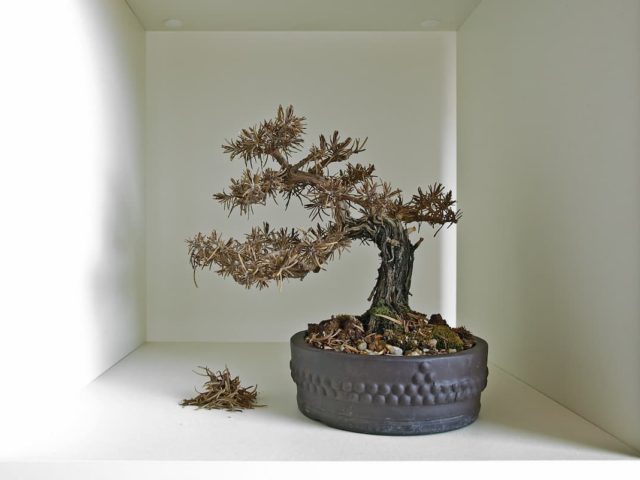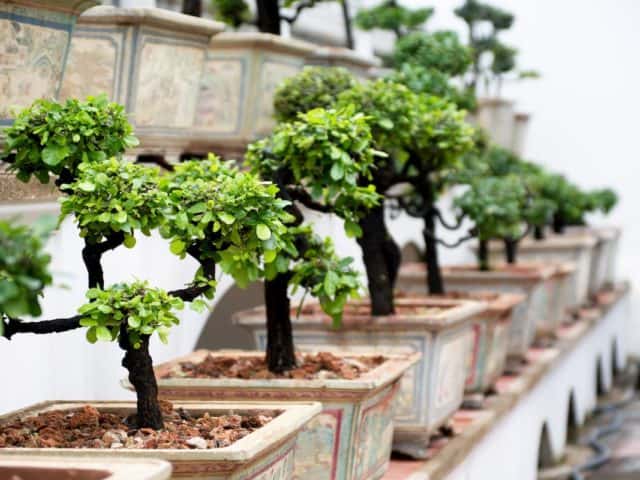If you already have an indoor bonsai and wondering how to water the plant properly without killing it, this blog is for you.
You might often struggle to figure out how to water it, without killing the bonsai. Some bonsai parents may struggle with overwatering it, while others may struggle with under-watering it.
The three best methods to water an indoor bonsai are the Top Watering, Bottom Watering, and Kitchen sink method. While Top Watering is suitable for overgrown and heavy bonsai trees, the Bottom Watering and Kitchen Sink method works best for small and lightweight bonsai trees.
Raising a Bonsai is an excellent art form. To raise a healthy bonsai, you need to know about the type of plant you are raising, its soil formation, and how to water it. In this blog, we will cover all these necessary details.

Best Methods to Water an Indoor Bonsai
Raising both outdoor and indoor bonsais requires a different amount and varied frequency of all kinds of attention. For an indoor bonsai, placing it near a south-facing window helps it receive all the necessary nutrients from the sun.
In many places worldwide, you can place the bonsai outdoors during summer, fall, and spring. Since it does not get as cold as during the winter seasons.
During these three seasons, it is also easy to water the plant without overwatering it. However, as the winter arrives and the sunlight gets lesser, you must keep an eye to not overwater it.
Here are three best methods on how you can water an indoor bonsai:
Bottom watering
If you have only started raising a bonsai and your tree does not mimic a fully-grown tree yet, you can try this bottom watering method.
Many people prefer this type of watering because it is easier to manage. If you are interested in bottom watering, all you need to do is:
- Fill a small tub, container, or bucket with water.
- Bring your bonsai tree with its pot and set the tree into the water-filled tub.
- Make sure that the water reaches the rim of the bonsai pot so that it can absorb water.
- Let the bonsai pot sit for at most half an hour. Depending on the size of the tree, half an hour works best.
- Once 30 minutes is over, you can carefully lift the bonsai pot and set it on its designated spot.
You can repeat this process after every two days or whenever you feel like the upper layer of the soil is getting dry.
Top watering
If you have ever owned a garden, if not a bonsai before, top watering is one of the most popular forms of the watering technique used worldwide.
You can use a watering can with tiny holes in the nozzle or a watering hose. The tiny holes in the nozzle resemble rainfall and create a gentle stream of water to the soil and the roots.
This method works best for overgrown bonsai trees, as overgrown trees require more water than the smaller bonsais.
You just need to hold the watering can or the watering hose above the tree and let the water saturate the soil until you feel it is enough.
Since you are watering an indoor bonsai, having a humidity tray under the bonsai pot will help you hold any overflowing water without spilling to the floor and staining it.
Kitchen sink
If you have an indoor bonsai, you can also water it under the kitchen sink. However, make sure that the tree with the pot is light enough so that you can carry it without any hassle.
Put the bonsai tree with the pot under the light stream of water from the sink, and let the water seep through the soil thoroughly. Once you feel like it is moist enough, and water runs through the drainage hole in the pot’s bottom, place the pot back on its spot.
Therefore, if you are planning to raise an indoor bonsai tree, you must be aware of what trees you should choose, where to place the indoor bonsais and how to take care of them.
Some indoor bonsais can also make use of high-intensity growing lamps as a substitute for sunlight.
So, while arranging a spot to place your bonsai tree, you must put it in a site where it can receive optimum sunlight, and they are exposed to all the natural season changes.
Soil preparation for the bonsai tree for the best water retention
To have a healthy and good-looking bonsai, you should prepare the soil full of nutrients and the correct way. The most crucial ingredients in preparing bonsai clay are Akadama, Pumice, Lava rock, gravel, and grit.
For fertilizing the soil, you can use organic potting compost that is available in stores and nurseries. You need to place the gravel/grit as the lowermost layer.
Since these particles can absorb water better than most of the other ingredients, using it in the lowermost layer gives the best drainage.
You can use crushed parts of akadama, pumice to bonsai soil to create a perfect mixture for potting the bonsai.
Akadama and pumice can absorb an adequate amount of water and keep the soil moist for a long time. These allow the roots to be well ramified and make the base of the tree stronger.
The lava rocks make the soil work best when it is in the topmost layer of the pot. Lava rocks have tiny holes in them, which makes for proper air pockets.
Using organic soil compost help the tree to get its necessary nutrients. When mixed with bonsai soil, the compost made from peat moss, sand and perlite work best for bonsai trees.
The watering routine you can follow for your bonsai trees
Properly watering your bonsai, with the right amount and correct frequency is important. Watering it regularly will make your bonsai healthier and in no time you will have a tree, that mimics its full-grown version.
Depending on the type of tree and category it belongs to, the watering routine may differ.
Deciduous
If your bonsai belongs to the deciduous category, you need to water it every other day when the tree is smaller, however as it grows you can water it daily. Keep an eye on the amount, so that you do not overwater.
Conifers
Parenting conifer bonsai trees require extreme caring in the watering part. You can only water it when you feel like the soil is dry enough.
Even if it is moist or wet and it is going to dry the next day or the day after, you should not water it. Coniferous trees’ roots are prone to rotting if overwatered.
Evergreen
If your bonsai tree belongs to the evergreen category, you can make it a routine to water it three times a week. Or water as occasionally you feel will work best for your bonsai.
If you have more than one bonsai tree, but all of it is of varied species, you cannot follow the same watering for each of the plants.
Keeping a close eye on the soil and potting of the trees, you can water the plant once you are sure your tree requires it. Overwatering kills the bonsai more often than under-watering does so be mindful of the watering need of your trees.
How to know when your bonsai needs water?
One of the best ways to remember to water your plant is when the soil is dry. However, don’t let it get too dry that the topmost layer of the soil crack opens.
If you are a beginner, you can use a bamboo chopstick to measure the soil moisture.
- Push the chopstick to the side of the soil and let it touch the base of the pot.
- If the chopstick comes out without any mud on it, you need to water your bonsai.
- If the chopstick has mud and water on it, check the moisture level again in two or three days.
You will get experienced when to water your tree after doing it a few times. You can also your finger and dip in the soil to figure out whether the soil is moist or dry inside.
The watering cans with holed-nozzles in them are the best option to water the tree. It distributes the water evenly, and the soil can soak up the water without much hassle.
Avoid using extremely cold water during the summer seasons, as the soil is warm from the sun and can cause the roots to decay. Instead of watering them in the daytime, you can water the plant in the mornings or the evenings.
How is watering an indoor bonsai different from watering outdoor bonsai?
Many people like to raise their bonsais to be an indoor plant, that mimics the shape, trunk structure of a full-grown tree to be a dwarf-sized version of it so that they can place it indoors, typically most bonsais are outdoor plants.
Watering an indoor bonsai is a bit trickier than the outdoor ones since it does not receive direct heat from the sun as the outdoor ones do. The more sunlight your bonsai gets, the better and healthier it becomes.
Final Thoughts on How to Water a Bonsai Tree Indoor
You have reached the end of this article. Now you are acquainted with the proper knowledge on how to water your indoor bonsai plant.





